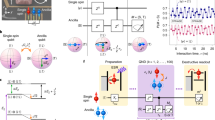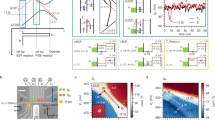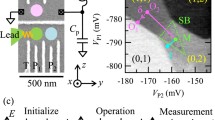Abstract
We present a physical model of spin quantum teleportation protocol (QTP) in a triple quantum dot array using a genetic algorithm approach. The information to teleport is spin-coded in one electron confined in a single quantum dot (SQD). The remaining double quantum dot (DQD) system has just an electron with spin that includes spin–orbit interaction. Charge and spin of the electron get hybridized with the site occupancy having two intrinsic quantum degrees of freedom. The DQD is prepared in a hybrid spin–orbit entangled (HES) Bell-like state with tunneling and site energies as time-dependent control parameters that are optimized by means of genetic algorithms (GAs). The hybrid entangled resources that we obtained allow spin-charge quantum state teleportation with a fidelity of 0.9972 and are used as a resource channel to establish the QT protocol. The spin state of the electron in the SQD interacts with the DQD spin–orbit entangled channel via a modulated exchange interaction to emulate Alice’s joint measurement required for QT with GA parameter control. A charge detection measurement in one of the DQD systems is sufficient to have the spin state teleported up to a unitary transformation. A specific joint measurement and unitary transformation were selected to test the protocol, and we obtain fidelity of 0.99 for the QTP. The quantum circuit models for both the spin–orbit entangled state and the teleportation are determined from the analysis of the stages of the controlled quantum dynamics obtained from the GA approach.






Similar content being viewed by others
References
Jozsa, R., Linden, N.: On the role of entanglement in quantum-computational speed-up. Proc. R. Soc. A Math. Phys. Eng. Sci. 459(2036), 2011–2032 (2003). https://doi.org/10.1098/rspa.2002.1097
Horodecki, R., Horodecki, P., Horodecki, M., Horodecki, K.: Quantum entanglement. Rev. Mod. Phys. 81(2), 865–942 (2009). https://doi.org/10.1103/RevModPhys.81.865
Pirandola, S., Eisert, J., Weedbrook, C., Furusawa, A., Braunstein, S.L.: Advances in quantum teleportation. Nat. Photon. 9, 641–652 (2015)
Bennett, C.H., Wiesner, S.J.: Communication via one- and two-particle operators on Einstein–Podolsky–Rosen states. Phys. Rev. Lett. 69(20), 2881–2884 (1992)
Bennett, C.H., Brassard, G., Crépeau, C.: Teleporting an unknown quantum state via dual classical and Einstein–Podolsky–Rosen channels. Phys. Rev. Lett. 70(13), 1895–1898 (1993)
Bouwmeester, D., Pan, J.W., Mattle, K., Eibi, M., Weinfurter, H., Zeilinger, A.: Experimental quantum teleportation. Nature 390, 575–579 (1997)
Riebe, M., Häffner, H., Ross, C.F., Hänsel, W., Benhelm, J., Lancaster, G.P.T., Wörber, T.W., Becher, C., Schmidt-Kaler, F., James, D.F.V., Blatt, R.: Deterministic quantum teleportation with atoms. Nature 429(17), 734–737 (2004)
Contreras-Pulido, L.D., Aguado, R.: Entanglement between charge qubits induced by common dissipative environment. Phys. Rev. B 77(15), 155,420 (2004)
Bernien, H., Hensen, B., Pfaff, W., Koolstra, G., Blok, M.S., Robledo, L., Taminiau, T.H., Markham, M., Twitchen, D.J., Childress, L., Hanson, R.: Heralded entanglement between solid-state qubits separated by three metres. Nature 497, 86 (2016). https://doi.org/10.1038/nature12016
Morton, J.J., Lovett, B.W.: Hybrid solid-state qubits: the powerful role of electron spins. Annu. Rev. Condens. Matter Phys. 2(1), 189–212 (2011). https://doi.org/10.1146/annurev-conmatphys-062910-140514
Gao, W.B., Fallahi, P., Togan, E., Delteil, A., Chin, Y.S., Miguel-Sanchez, J., Imamog̃lu, A.: Quantum teleportation from a propagating photon to a solid-state spin qubit. Nat. Commun. 4, 2744 (2013). https://doi.org/10.1038/ncomms3744
Dresselhaus, G.: Spin-orbit coupling effects in zinc blende structures. Phys. Rev. 100(2), 580–586 (1955)
Perel, V.I., Tarasenko, S.A., YAssievich, I.N., Ganichev, S.A., Bel’kov, V.V., Prettl, W.: Spin-dependent tunneling through a symmetric semiconductor barrier. Phys. Rev. B 67, 201,304 (2003)
Bang, J., Yoo, S.: A genetic-algorithm-based method to find unitary transformations for any desired quantum computation and application to a one-bit oracle decision problem. J. Korean Phys. Soc. 62(12), 2001 (2014). https://doi.org/10.1038/nature12016
Holland, J.C.: Adaptation in Natural and Artificial Systems, primera edn. The University of Michigan Press, Michigan (1975)
Krause, J., Reitze, D., Sanders, G., Kuznetsov, A., Stanton, C.: Quantum control in quantum wells. Phys. Rev. B 57(15), 9024–9034 (1998)
Navarro-Muñoz, J.C., Rosu, H.C., López-Sandoval, R.: Genetic algorithm optimization of entanglement. Phys. Rev. A 74, 52308 (2006)
van der Wiel, W.G., De Franceschi, S., Elzerman, J.M., Fujisawa, T., Tarucha, S., Kouwenhoven, L.P.: Electron transport through double quantum dots. Rev. Mod. Phys. 75, 1 (2002)
Liu, Y.S., Yang, X.F.: Enhancement of thermoelectric efficiency in a double-quantum-dot molecular junction. J. Appl. Phys. 108, 023710 (2010)
Menichetti, G., Grosso, G., Paravicini, P.: Analytic treatment of the thermoelectric properties for two coupled quantum dots threaded by magnetic fields. J. Phys. Commun. 2(5), 55026 (2018)
Petta, J.R., Johnson, A.C., Taylor, J.M., Laird, E.A.: Coherent manipulation of coupled electron spins in semiconductor quantum dots. Science 309, 2180 (2006)
Koppens, F.H.L., Buizert, C., Tielrooij, K.J., Vinik, I.T., Nowack, K.C., Meunier, T., Kouwenhoven, L.P., Vandersypen, L.M.K.: Driven coherent oscillations of a single electron spin in a quantum dot. Nature 442, 766–771 (2006)
Shi, Z., Simmons, C.B., Prance, J.R., King Gamble, J., Seng Koh, T., Shim, Y.P., Hu, X., Savage, D.E., Lagally, M.G., Eriksson, M.A., Friesen, M., Coppersmith, S.N.: Fast hybrid silicon double-quantum-dot qubits. Phys. Rev. Lett. 108, 140503 (2012)
Nilsson, M., Chen, I.J., Lehmann, S., Maulerova, V., Dick, K.A., Thelander, C.: Parallel-coupled quantum dots in InAs nanowires. Nano Lett. 17(12), 7847–7852 (2017). https://doi.org/10.1021/acs.nanolett.7b04090
Hetano, T., Tokura, Y., Amaha, S., Kubo, T., Teraoka, S., Tarucha, S.: Excitation spectroscopy of few-electron states in artificial diatomic molecules. Phys. Rev. B 87, 241414 (2013)
Sattler, K.D.: Handbook of Nanophysics. Nanoparticles and Quantum Dots, primera edn. University of Hawaii-Manoa, Honolulu (2010)
Gittings, J., Fisher, A.: Describing mixed spin-space entanglement of pure states of indistinguishable particles using an occupation-number basis. Phys. Rev. A 66(3), 032305 (2002). https://doi.org/10.1103/PhysRevA.66.032305
Wang, H., Kais, S.: Quantum teleportation in one-dimensional quantum dots system. Chem. Phys. Lett. 421(4–6), 338–342 (2006). https://doi.org/10.1016/j.cplett.2006.01.093
Visser, R.L., Blaauboer, M.: Deterministic teleportation of electrons in a quantum dot nanostructure. Phys. Rev. Lett. 96, 246801 (2006)
Bader, S., Parkin, S.: Spintronics. Annu. Rev. Condens. Matter Phys. 1(1), 71–88 (2010). https://doi.org/10.1146/annurev-conmatphys-070909-104123
Bell, J.S.: On the Einstein–Podolsky–Rosen paradox. Physics 1, 195–200 (1964)
Haupt, R.: Comparison between genetic and gradient-based optimization algorithms for solving electromagnetics problems. IEEE Trans. Magn. 31(3), 1932–1935 (1995). https://doi.org/10.1109/20.376418
Zingg, D.W., Nemec, M., Pulliam, T.H.: A comparative evaluation of genetic and gradient-based algorithms applied to aerodynamic optimization. Revue européenne de mécanique numérique 17(1–2), 103–126 (2008). https://doi.org/10.3166/remn.17.103-126
Carbonneau, P.: Genetic algorithms in astronomy and astrophysics. Astrophys. J. Suppl. Ser. 101, 309–334 (1995)
Hill, S., Wootters, K.: Entanglement of a pair of quantum bits. Phys. Rev. Lett. 78(26), 5022–5025 (1997)
Nielsen, M., Chuang, I.L.: Quantum Computation and Quantum Information, 1st edn. Cambridge University Press, Cambridge (2000)
Studer, M., Walser, M.P., Baer, S., Rusterholz, H., Schön, S., Schuh, D., Wagscheider, W., Enssin, K., Salis, G.: Role of linear en cubic terms for the drift-induced Dresselhaus spin-orbit splitting in a two-dimensional electron gas. Cond. Mat. Hall, pp. 1–7 (2010)
Bonestel, N.E.D., Stepanenko, D., DiVincenzo, D.P.: Anisotropic spin exchange in pulsed quantum gates. Phys. Rev. Lett. 87, 207901 (2001)
Acknowledgements
The first author expresses his gratitude to CONACyT-México for the scholarship received and upholds that most part of this work was developed as part of his master thesis.
Author information
Authors and Affiliations
Corresponding author
Rights and permissions
About this article
Cite this article
Domínguez-Serna, F., Rojas, F. Spin–orbit hybrid entangled channel for spin state quantum teleportation using genetic algorithms. Quantum Inf Process 18, 32 (2019). https://doi.org/10.1007/s11128-018-2142-0
Received:
Accepted:
Published:
DOI: https://doi.org/10.1007/s11128-018-2142-0




